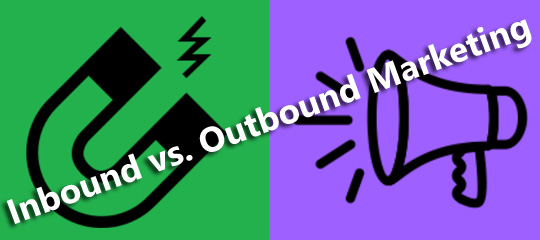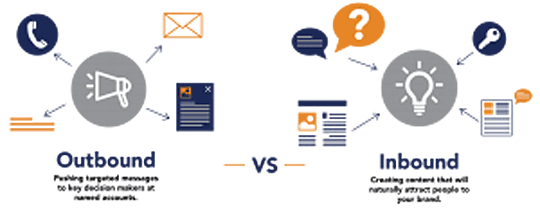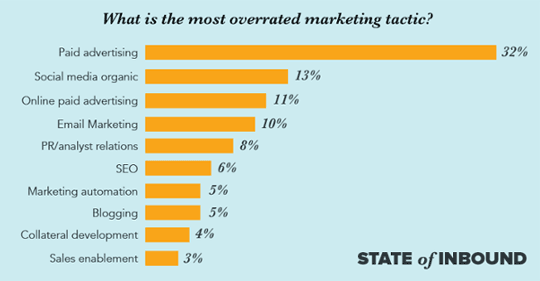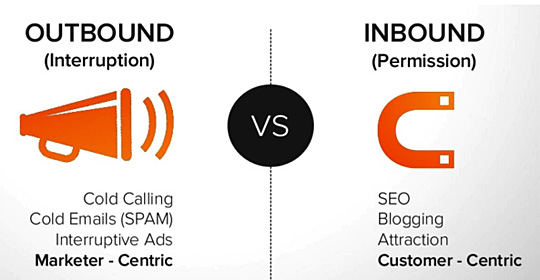The debate about inbound and outbound marketing has been raging for years. As a small or medium-sized business, it can be unnerving to choose between the two types of marketing. However, studies show that nearly 90 percent of a business’ marketing resources are still channelized to outbound marketing. So, where does that leave your business? Should you opt for outbound marketing because other businesses are focusing on it? Should you use business directories to list your business for Local SEO? The answer is not that simple.
While outbound marketing has been the mainstay of most marketing strategies, things are now changing. Today, inbound marketing is gaining a strong foothold, and this is primarily due to the rising popularity of social media where brands can enjoy near real-time marketing and see tangible results.
This coming year, inbound marketing will be more important than outbound marketing, which has been ruling the roost for some time. However, business and online marketers are still working on their outbound marketing strategies, so there will be many improvements and tricks that will crop up in 2018 that other business can emulate. Until now, nearly 80 per cent of B2B marketers use email campaigns to grow their outreach and expand their business. However, it is anticipated that 2018 will be different from the preceding two years.
What Do Numbers Say About Inbound and Outbound Marketing?
Inbound and outbound marketing statistics paint a very different picture and let you look at results and analyze them. You will be better placed after understanding the figures as to which one would be the marketing strategy of choice in 2018.
- Nearly 68 per cent marketers opine that inbound marketing is more effective compared to outbound marketing
- About 48 per cent marketers feel that outbound marketing reaps the right result for their business
- Nearly 52 per cent online marketers have claimed that their outbound marketing efforts have been futile while 32 per cent feel the same about inbound marketing
- Inbound marketing offers better return on investment compared to outbound marketing, with 46 per cent claiming that inbound offered superior results while 12 per cent reported having better return on investment
- Inbound marketing tends to ensure high-quality leads for conversion compared to outbound marketing. At least, that is what 59 per cent online marketers said as opposed to 16 per cent who thought otherwise
- In 2016, inbound marketing offered better lead generation compared to outbound marketing according to 52 per cent surveyed marketers
Another report also found that marketers tend to prefer inbound marketing strategies compared to outbound strategies. Around 68 per cent were satisfied with their organization’s outbound marketing efforts. Although nearly a third of marketers surveyed for this report felt outbound marketing was getting too much credit. In 2017, 32 per cent online marketers and businesses felt that using paid advertising was an utter waste of resources as well as time.
One of the biggest problems that marketers face is generating quality traffic and leads. Nearly 63 per cent businesses and online marketers stated this. This goes to show that in this day and age, you and your business have to work hard to generate the right traffic, and the marketing strategy that you adopt will have a profound effect on your traffic, leads and conversion rate.
Strategies For Inbound and Outbound Marketing
Inbound marketing is about taking complete strangers and converting them into paying customers. It involved producing the right content, ensuring it is visible online, and then making your prospective (and existing) customers aware of your online presence. This marketing tactic is about nurturing and fostering relationships that you build online.
On the other hand, outbound marketing is akin to traditional marketing strategies. Yes, it is about being loud and vocal through ads on the face of prospective customers and persuading them to buy your product and service.
Both inbound and outbound marketing require different strategies and that is what you need to know in order to figure out which one is best suited for your business.
Inbound Marketing Strategies:
- Be Clear About Your Target Audience: You should know your target audience inside out. This means knowing the needs and objectives to buy a product or service. It only then that you can create a comprehensive plan to convert these unknown strangers into paying customers.
- Get Your Content Strategy Clear: Once you know your target audience, you can create content based on their needs. However, just creating is not sufficient. You need to also distribute the content. This means knowing where they hangout online. Look at social media channels like Facebook, LinkedIn and Twitter. There are number of ways to reach out to your prospective customers and then it is matter of finding out which one works best. Remember, SEO is important in inbound marketing. TribeLocal is your partner for local SEO. Its single dashboard allows you to track rankings, traffic, and performance.
- Build and Nurture Relationships: Inbound marketing is not about hardsell. Rather, it is soft selling technique as every prospective customer will not be ready to shell out cash on reading your content. So, focus on building relationships and nurturing trust and reliability. This will automatically translate into conversion. Don’t harp over hot leads only as you will be missing out on a whole chunk of prospective customers.
Outbound Marketing Strategies:
- Create Innovative Ads: You need to create a number of innovative ads to inform your audience the benefit of buying your product or service. So, be clear about what you offering, why someone should buy and lastly, have a definitive call-to-action.
- Make Ads Attractive: Remember, people are bombarded by ads throughout the day. Many just ignore them or delete them after reading. Also, people have limited attention span. So, whether you are conducting an email campaign or using a billboard, your copy should attract eyeballs. Check out your competition and come up with content that sets you apart. This is one of the best ways to stand out in a crowd and hold people’s attention.
- Test and Optimize: Businesses no longer have the luxury of large budgets for marketing. So, with limited financial resources, you need to ensure you get a bigger bang for your adverts. Try reading your ads from the perspective of your target audience. Would you click or act on it? If not, go back to the drawing board and tweak your ad until you are satisfied. Use different copies and Google Analytics to analyze the metrics. You can use TribeLocal with Google Analytics to ensure you have the right SEO metrics in place to do the right analysis. This way, you will be able to figure out which ad is working and which one requires more tweaking.
Which Is Better – Inbound Or Outbound Marketing?
While most online marketers agree that small, local and niche businesses benefit more from inbound marketing, as it is educational and informative rather than being pushy and promotional, you should choose your online marketing strategy based on different parameters.
- Your Target Market: Take into account your audience and how they usually shop for the product or service you are offering. Find out where they usually shop for these solutions. It is best to check your direct competition and learn their marketing tactics. You can replicate them but in a better way so that your marketing strategies are more effective.
- Determine Your Goals: Determine what you want achieve through your marketing endeavors. Do you want to build brand awareness, increase traffic or get leads? Then you will know which marketing strategy is best suited to help you achieve your goals.
- Brand Image: Consider how the marketing tactic that you use will impact your brand. If it benefits your brand and also ensures your target audience would approve of the strategies, go for it.
Inbound marketing requires patience and will yield results over time. On the other hand, outbound marketing helps you get customers quickly, but offers diminishing returns. Usually, it is best to combine inbound and outbound that help you enjoy short-term growth along with long-term brand building and customer acquisition.
Usually, small businesses can go with inbound marketing while mid-sized business with slightly larger marketing budgets can combine inbound and outbound. But do check both strategies to find out which one gives you the best return on investment.
[Image sources:Artillery Marketing, State of Inbound 2017, KEO Marketing]
Shishir is an ex-startup entrepreneur currently working on kickstarting inbound marketing for a Silicon Valley startup. Cracked the code of generating 750K monthly traffic in 10 months by using creative content.



